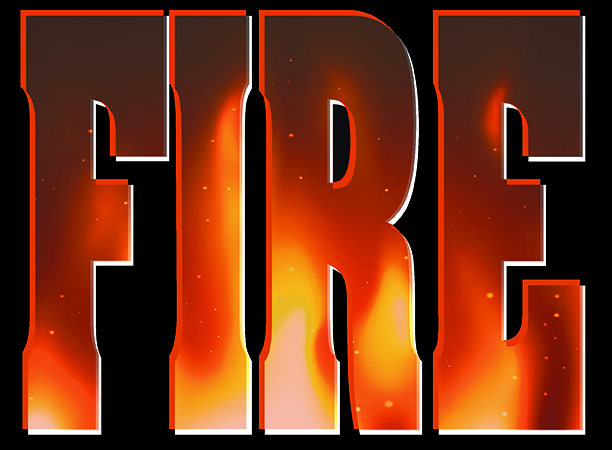
Fire: A Dangerous Four Letter Word
By Robin Walters
“I’ve been putting out the fire with gasoline.” David Bowie
Fire is one of those topics that great writers often romanticize. You’ll find fire as a metaphor in poems, stories and songs throughout history. Our ability to start fire and use it to warm and feed ourselves has helped our civilizations thrive until we are the undisputed masters of the entire world and the space around it.
The great irony of fire is that it warms and comforts us, but is also an incredible danger to our homes and loved ones. In 2009, the National Institute of Standards and Technology published a video that illustrates how quickly fire can spread in a home. Those of us who live in wildfire country know all too well how one discarded cigarette can turn dry brush into a conflagration.
As much as we understand fire and its effects, what most of us don’t really understand is how to put one out. We rely on 911 and the experts dispatched to save us. Unfortunately, fires happen all too often. The 2015 statistics from the National Fire Protection Association (NFPA) state:
- Annually, there are more than 1.3 million fires in the U.S., causing 3,280 deaths and $14.3 billion in property damage.
- The most frequent fires occur outside, followed by structural and then vehicle fires.
- Fire rescue units are typically dispatched somewhere in the U.S. every 23 seconds.
Types of fires
Not all fires are the same, but it left unchecked, all fires can be equally damaging. The experts in fire prevention have classified the types and severity level of fires, depending on the fuel and whether electricity is involved:
- Class A Encompasses solids, such as woods, plastics or clothing.
- Class B The liquid class, including gasoline, oils or paints.
- Class C Flammable natural gasses, such as the gas that powers your stove.
- Class D Combustible metals, such as magnesium.
- Class E Fires sparked from electricity.
- Class F Common kitchen fires, encompassing oils and fats.
The NFPA says these are the most frequent causes of fire in the home:
- Appliances and equipment, including dryer vent fires.
- Arson and property crimes involving deliberate fire setting or children playing with matches.
- Candles, especially in the winter.
- Chemical and LP-gas fires.
- Fireworks in the summer.
- Holiday lighting fires from Christmas trees and other decorations.
- Fires caused from lightning strikes.
- Smoking in the home or outside.
How to extinguish fires
Everyday preparedness should encompass thought and discussion with your family about how to prevent fire in and around your home, as well as how to act should one occur. As in any survival situation, the first step is to consider what you would do if the worst happens.
Let’s start with fire extinguishers. While you should always call 911, because small fires can quickly become large ones, a fire extinguisher is a mandatory addition to any home safety kit. As you probably already know, there are fire extinguishers designed specifically for different types of fires that can occur. Travelers Insurance has an excellent info-graphic to help you discern extinguisher types:

Most big box retailers sell these tools with prices ranging from $35 to $75. In my home, I keep three extinguishers:
- Type A – near my wood stove.
- Type K – under my kitchen sink.
- Type C – in my garage.
I highly recommend learning how to use extinguishers by taking FEMAs free CERT (Computer emergency response teams) classes. Look online; the Department of Public Safety in your community may offer a free class where you and your family can practice putting out small fires with an extinguisher. Every October, your kids probably even get a school visit from a firefighter teaching “stop, drop and roll” during National Fire Prevention Week. Watch for free classes, smoke alarm giveaways, and all kinds of other events in your community, including how to use a fire extinguisher, during that annual event.
The basic method for using an extinguisher is PASS: Pull, Aim, Squeeze and Sweep. Pull the pin, aim the nozzle, squeeze the handle, and spray the fire side to side as you extinguish it.
Please take caution: fighting any fire is dangerous. Fortunately, many of us live in an area where we can call professional firefighters for help. With that said, here are some common scenarios, and how you should combat them:
Scenario one: You’re cooking a hamburger and the kids distract you. When you come back to the stove, the hamburger is on fire.
What to do: Tell the kids to get outside, and call 911. Never throw water on a grease fire, which will only spread it. Use a K or B rated fire extinguisher, or, if the fire is still in the pan, and cover the pan with a lid. If it’s safe to do so, turn off the stove. Do not touch the pan until it is completely cool. You can also smother a grease fire with baking soda. Don’t turn on the exhaust fan until the fire is out. Of course, if the flames are too high, get out immediately.
Scenario two: You’ve had a power outage so you’ve deployed the kerosene heater. You know about the carbon monoxide danger, so you have a window open. But your child tosses a blanket and it lands too close to the heater. It ignites.
What to do: Kerosene heaters are incredibly dangerous, in part because of their emission of carbon monoxide. Assuming they are properly vented, and you turn them off at night, they can be used. If you use one, make sure it’s never blocking an exit out of the room. If fire occurs, get the family outside and have them call 911. If the fire is small, try smothering it with a blanket or use a class C extinguisher. Do not use water.
Other common fires and how to stop them:
| Electrical appliances | Remove source of electricity and smother. 1. Switch off appliance. 2. Pull out plug. 3. Smother with a blanket or type C extinguisher. Never use water, which can conduct electricity. |
| Charcoal grill | Smother it. 1. Put on heavy-duty oven mitts. 2. Cover with the lid (vents closed). Never use water – you’ll explode a cloud of steam that could burn you. |
| Car fire | Use a fire extinguisher. 1. Get off the road. 2. Turn off ignition. |
Fire Prevention 101
Truly the best way to stop a fire is to make sure it never starts. Here is my top 10 list of regular fire safety practices to initiate now, before a crisis occurs:
- Talk about and practice fire drills with your family. Have a bug out plan? You should also have a fire evacuation plan.
- Never leave unattended fires in your home.
- Install smoke and carbon monoxide detectors throughout your home. We make it a habit to change the batteries with the time changes in the spring and fall.
- Invest in fire extinguishers and fire blankets.
- Have your chimneys and dryer vents cleaned every few years.
- Change your furnace filters regularly.
- Don’t overload your electrical outlets.
- Don’t store flammables, such as gasoline or kerosene, near your home.
- Don’t smoke in bed.
- Keep flammable items away from fire sources; never lay a dishtowel on the stove; never leave a candle unattended near a curtain, etc.
The unpredictability of fire is what makes it so dangerous. A little proactive preparation will help ensure you and your family are ready should a fire ever occur.
Robin is a writer, organic farmer, prepper, and dog mom. By day, she’s a marketing/communications/sales exec; by night, a content author.



